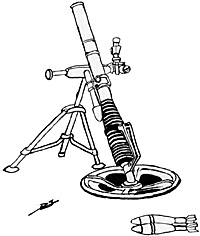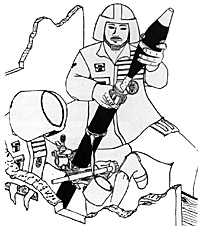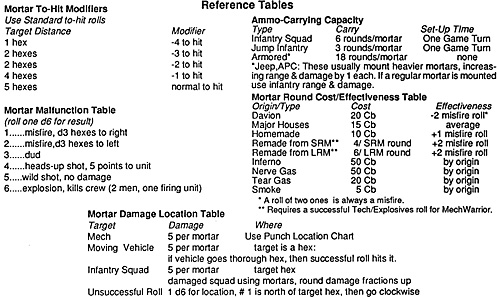 "Gentlemen, I think we are dead,"
said the Lieutenant, as he peered at the
pass through the binocs, He was not
happy with what he saw, Four light Mechs
(two Wasps, a Slinger, and a Locust) were
tip-toeing through the pass as if they were
on their way to apicnic. The Lieutenant's
platoon had been assigned to blow the
ridge above the pass and close It off
before the first scout lance of mercenary
Mechs come through. Intelligence back at
Bose had said that the first Mechs wouldn't
be through for twelve hours, but he should
have known better than to believe that.
"Gentlemen, I think we are dead,"
said the Lieutenant, as he peered at the
pass through the binocs, He was not
happy with what he saw, Four light Mechs
(two Wasps, a Slinger, and a Locust) were
tip-toeing through the pass as if they were
on their way to apicnic. The Lieutenant's
platoon had been assigned to blow the
ridge above the pass and close It off
before the first scout lance of mercenary
Mechs come through. Intelligence back at
Bose had said that the first Mechs wouldn't
be through for twelve hours, but he should
have known better than to believe that.
He put down the binocs and looked at his two sergeants,
"Gentlemen, we have failed In our mission, and It's doubtful that we can engage this lance without getting destroyed, Bose can't send back-up for another twelve hours, but If we let them through here, Base has had it, I'm in a quandry,'
Both sergeants nodded. McKeag, the more experienced, cursed harshly enough to do a Roman Centurion proud,
"I told those (deleted expletive) to give us some heavier (deleted) weapons, but they kept whining about the (censored) front to the north, A couple of Infernos, or even some (censored) man- portable rockets, or even a lousy (deleted) laser would help, We got fifteen kilos of explosive, a flamer, on 7mm machine gun, and a (deleted) platoon of (censored) assault rifles, pistols, knives, and fists. "
'One Mech we could take, with luck," commented the younger sergeant, "We've got surprise and high ground, and wide dispersion, But with a whole lance, they can triangulate and blow us to Hell."
"How about a (censored) air strike, Lieutenant?"
The officer shook his head, still looking at the approaching enemy, "Bose needs all the jets and Aerospace fighters it has for the Northern defense, They sold that maybe, MAYBE they might be able to spore a light VTOL scout, in six hours."
"I say we (deleted) bug out, sir, There ain't no use stayin' here just to get kilt by one of them (descriptive term meaning enemy Mechs).'
"No, Sergeant, as much as I'd love to bug out, I'm afraid we are going to have to hold them. It's either fight them here, or fight them later. We have a better chance herein the mountains."
Fight them with what, sir? Begging your pardon, but we have one, repeat one vehicle with a 7mm machine gun. A 7mm gun on a jeep does not a tank division make.'
"True.' The lieutenant thought for a minute. "McKeog, before we left, the Supply Sergeant stuffed a couple of crates in the back of the jeep and muttered something about emergencies, What was that?"
The older sergeant looked pole. 'Sir, you can't be serious! Those were some homemade mortars made in local machine shops and garages around base, just for kicks. Local kids to young to joln up were turning them out to 'do their part 'or the war, There's about ten of 'em in the crate, and the other two crates are filled with ammo. But, Sir, you can't want to use mortars against Mechs! It'd be suicide!"
"It's suicide any way I look at it, McKeog. What do they fire, homemade rounds?"
"No, sir, "sold the younger sergeant, Toshio. "House Davion surplus rounds. Standard, There's a whole mess of 'em back at Bose.'
"So they probably won't explode in our faces, Good, Toshio, get your squad set up on the west slope of this hill and dig In with the mortars. McKeog, get your squad dug into covering positions. Radio Base that we ore going to try to tie these bozos up for a while, until they can send help, Or until we buy it. Either way, we aren't going to move."
The Lieutenant looked again through his binocs at the enemy below, He knew he had little chance of surviving this encounter. Mortars were a poor man's weapon, and weren't very accurate. Infantry-to-Mech combat was bad enough when it was one platoon on one Mech, with Infernos and SRMs and losers, With one platoon on FOUR Mechs with nothing but a handful of mortars and rifles, this would be suicide. It would take every ounce of luck the platoon had to score even one hit,
But Lieutenant Baker was feeling lucky today..
Mortar History
The mortar has been around for centuries, from the very first it was evident that though an enemy's walls might be fearsome, his ceiling might be weak. Gravity was the key. Arcing fire from the first mortars laid waste to many a stronghold, and the practicality of the mortar was demonstrated. During the old days of cannon and gunpowder, it took less iron and bronze to build a mortar than to make a cannon. As weapons technology advanced, mortars became smaller and more devastating, eventually becoming man-portable supporting fire units. Yet they still remained one of the least favorite weapons of infantry, which preferred more personal weapons. Mortar training has continued in almost every army throughout the years of the Succession Wars, though it is used less and less often.
Mortars still remain a poor man's weapon, for they are simple in design and cheap in construction. Any decent machine shop can turn out several in a week or so. This makes them very appealing to those low-budget insurgent operations and those petty rebellions on backwater worlds.
Guerillas and Irregulars of every sort favor them, fort here are few other support weapons at their disposal. Infantry regiments with more money tend to buy more sophisticated manportable lasers and SRMs, almost sneering at the archaic design of the mortar. Yet lasers can malfunction or power down in the field, SRMs can run out of ammo quickly, and both are expensive to lose. Mortars and mortar rounds are cheap.
The modern mortar round has changed little from the first ancient man-portable units. A simple rocket propellent on bottom, a high explosive on top, and a case to surround them both. The mortar itself is a simple steel tube with a firing mechanism at the foot. To use, figure the arc of the shot, place the mortar appropriately, drop in the round, and pray. Simple, they are. Accurate, they are not.
Among the Successor Houses, where precision guided munitions are the rule, the mortar is seen as a clumsy, random, weapon, almost as dangerous to its user as to its target. This is a bit of an exaggeration, but the weapon does have a nasty habit of malfunctioning in one way or another. Explosions in the mortar itself, sending shards of shrapnel among its crew, are less-than- rare occurrences. When a mortar is fired at an enemy that is too close to the firing location, it is possible that the mortar round will find its way back to the crew. Wild shots are also possible. Freak occurrences happen more than is comfortable to the average infantryman.
Yet, pound for pound, the mortar is a very efficient and cheap weapon. It can even be devastating in the right situation. You just have to be lucky, that's all.
Mortar Use In Simulation Play
A mortar round is usually made up of a rifle unit, either jump, mounted, or on foot. Since it takes two men to fire a mortar, halve the usual number of shots per turn for a platoon. Subtract one to-hit point for each hex closer than five; a malfunction could very possibly be a round returning on the crew.
The maximum range of a mortar is five hexes, and its minimum range is two The round, at five hexes, travels up two hexes; at four, it travels up three hexes, at three, it travels up four hexes; at two, it travels up five hexes, and at one it travels up six hexes. Buildings, mountains, etc, can and do get in the way of a shot, if they are not planned for, but because the shot is an arc, these factors may be taken into account, and shots can be lobbed over such obstacles from a place of cover. For simulator use, you may wish to require line-of-sight spotters to accurately call the targeting. These could be hidden infantry, friendly Mechs or aircraft, satellite cameras, etc.
After establishing that your infantry unit has decided to plant mortars (it takes one round to plant and prepare loads), the unit may fire for three rounds before it needs to stop and allow the mortars to cool. If fire is continued for more than three rounds, the mortar begins to overheat; it has a 2 in 6 chance of malfunctioning each round. If a mortar is used for six consecutive rounds, the seventh shot will automatically explode, doing six points of damage to the unit.
If a double one ('snake eyes') is rolled, the mortar automatically misfires. Use the Malfunction table below for results.
Mortar fire does 5 points damage on a direct hit. When damage is being done to a Mech, use the Punch Location chart for the location of the damage.
Actually hitting a moving target is a matter of luck. The firing crew picks a position within range that it deems as the target, and fires. If a successful hit is scored, then the full damage is taken by the target. If the round misses, a die is rolled. With a '1' being north, proceeding clockwise, the round lands in the indicated hex, doing full damage to whatever is within it. Including the crew.
If a Mech moves to within one hex of a mortar crew, that crew may then switch to their regular weapons the next round, abandoning their mortars. If a crew is wounded, then the number of functioning mortars is half that of the number of functional soldiers. Round all fractions down.
A mortar squad usually has enough ammunition to fire all its guns six times.
A tremendous amount of firepower can be brought to bear by mortars. Even a sixteen man jump unit that carries mortars can pull a possible 40 points of damage. The chances of all eight mortars hitting in one location are very slim.
Special Mortars
There are a few special types of mortars in use. Inferno rounds are rare, but effective. They act just like normal SRM inferno rounds. Few crews feel comfortable about launching liquid fire from a gun that could malfunction at any time, however. Gas rounds are also used, loaded with either toxic, noxious, or simple colored smoke. These work best against infantry, as Mechs have protective life support systems. Should a Mech's life support be damaged, on the other hand...
Mortars may also be used from vehicles, such as jeeps and armored personnel carriers. For these units, there is no oneround setup time, as the mortars are mounted in the ready- to-fire position. They can carry three times as much ammo as foot crews. Heavier mortars can be mounted on vehicles, increasing all range and damage numbers by one.
Jump crews carry only half as much ammo, for weight's sake.
Mortars In the Inner Sphere
Each of the Houses produces a standard mortar. The best ones are made for Davion worlds. These high-tech guns have excellent cooling systems (Firing four rounds instead of three before requiring cooling), as well as special distancerange calculators that help the accuracy of the gun. They are made of a light super-alloy, and can go rather a long time without needing cleaning or maintenance. They also have less of a tendency to explode. Cost, new, is about Cb 400.
House Marik produces a similar model without the computerization, but with the 4-round cooling system. Cost is Cb 300. The rest of the Great Houses produce standard mortars with no distinguishing qualities for about Cb 250 each.
Backwater and Periphery planets that have little heavy industry can easily make mortars of useable quality, but these are not as good as mass-produced mortars. They must cool after two rounds of firing, and they tend to malfunction more. They are twice as heavy as military models, being made f rorn steel and iron instead of ceramics and alloys. These homemade mortars go from Cb 50 to Cb 100.
The same explosive and propellent that are used in SRM's and LRM's can be used in mortar production. If cannibalized, one SRM round yields enough of both to make four mortar rounds, and one LRM round yields enough to make six mortar rounds. It's no wonder that invading mechwarriors try to police a battlefield of downed Mechs as soon as possible after a battle. One dead Mech with a small SRM magazine can yield dozens of first rate mortar rounds, and a dead Archercan arm a small army! It takes an excellent Explosives skill to do this. An unskilled person could very well destroy himself and his ammo the first time he tried it. Homemade mortar rounds cost Cb 10 a round.
House Davion produces the finest rounds, which sell for Cb 20 a round. They are worth it, for they don't tend to explode in one's face. The other Houses produce average rounds for Cb 15 apiece. Inferno rounds cost Cb 50 each, and gas rounds are Cb 5, Cb 20, and Cb 50 for smoke, tear gas, and nerve gas, respectively.
 In Action
In Action
"There she goes!" yelled a corporal on the hill below them, His announcement was followed by a rumbling as the cliff side above the pass crashed to the ground, making it impossible by Mech or foot, Their mission was accomplished.
True, the Lieutenant was only taking half as many men back with him as he hod started with, ondsome of the dead were going to be missed sorely. Nor more would Sgt McKeags command of invective pierce the (deleted) morning air, Corporal Won had taken command of the few men left in his squad, They had taken an awful licking, but they were still alive, which counted for something. Two Mechs lay dead and burning under the rubble of the cliff side. The Stinger had retreated, trolling a line of parts and shreds of armor, The concentrated mortar fire hod done the job well, and taken the entire lance by surprise, While they had been flailing around, looking for targets, two different crews had landed shells on the head of the Locust, shattering its cockpit and killing its pilot.
The Wasps had finally discovered where the fire was coming from, just in time for he next volley of shells to impact on the chest of one, killing an engine and opening up a gaping hole. The Stinger had peppered the hillside with loser and machine gun fire before the third salvo knocked it around. The damaged Wasp had exchanged some fire before it, too took another lucky shot to the center torso, The other Wasp, confused and shaken, raised its arms and opened its hatch, signaling surrender. Its pilot was even now tied up in the back of the jeep, cursing his luck.
The mortar fire did it, There had been some fire from the 7mm and the assault rifles, but the damage had come from the mortars, Drop a rock on the enemy's head, reflected the Lieutenant, and he starts to worry. There was no doubt in his mind now. The next time he took a unit into the field, every other man would have a mortar stropped to his bock. They might be cheap, but they could do a lot in the right place,
"Load up, you grunts!" he bellowed. "It's a long hike back to Base and I wont to be there by nightfall, Won, your squad takes point. Toshio, back him up, Move! There's a poker game over in Supply tonight, and I want in."
The Lieutenant was feeling lucky today.

Back to BattleTechnology 13 Table of Contents
Back to BattleTechnology List of Issues
Back to MagWeb Magazine List
© Copyright 1990 by Pacific Rim Publishing.
This article appears in MagWeb.com (Magazine Web) on the Internet World Wide Web.
Other military history articles and gaming articles are available at http://www.magweb.com